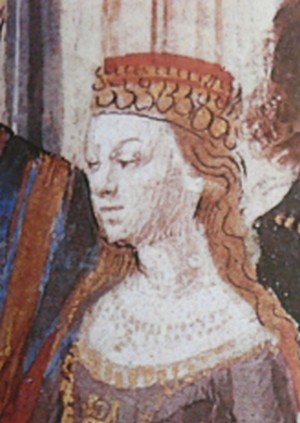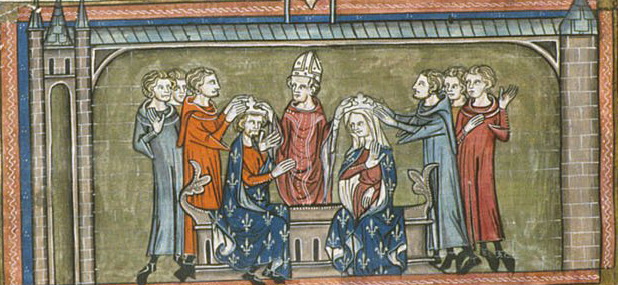|
Maria Of Anjou, Queen Of Majorca
Maria of Anjou (1290 – end of April 1346/January 1347) was a member of the Capetian House of Anjou who served as Queen of Majorca during her marriage to King Sancho of Majorca. She was the daughter of King Charles II of Naples and his wife, Mary of Hungary. Maria married King Sancho by proxy at Palma de Majorca on 20 September 1304 and in person in 1308. The marriage produced no children, which threatened the survival of the young independent state. Sancho willed the kingdom to his nephew James to prevent it from falling to the Crown of Aragon, and died in 1324. Two years after Sancho's death, Maria married James of Ejerica, a member of the House of Barcelona. She was imprisoned in Jerica in 1331 by King Alfonso IV of Aragon, and was later transferred to Valencia. Her brother, King Robert of Naples, arranged her release, and she left Valencia after June 1337 for Barjols in Provence Provence is a geographical region and historical province of southeastern France, whic ... [...More Info...] [...Related Items...] OR: [Wikipedia] [Google] [Baidu] |
Queen Consort Of Majorca
This is a list of consorts of the Kingdom of Majorca. Queen consort of Majorca House of Aragon See also *List of Hispanic consorts *List of Aragonese consorts *Countess of Barcelona *List of consorts of Montpellier *List of Castilian consorts *List of Asturian consorts *List of Leonese consorts *List of Galician consorts *List of Navarrese consorts *List of Spanish consorts *Princess of Girona, Lady of Balaguer Notes {{Spanish Kingdoms Majorcan queens consort, Women of medieval Spain Lists of queens, Majorca History of Mallorca, Royal consorts Lists of Spanish royal consorts, Majorcan consorts ... [...More Info...] [...Related Items...] OR: [Wikipedia] [Google] [Baidu] |
Provence
Provence is a geographical region and historical province of southeastern France, which stretches from the left bank of the lower Rhône to the west to the France–Italy border, Italian border to the east; it is bordered by the Mediterranean Sea to the south. It largely corresponds with the modern administrative Regions of France, region of Provence-Alpes-Côte d'Azur and includes the Departments of France, departments of Var (department), Var, Bouches-du-Rhône, Alpes-de-Haute-Provence, as well as parts of Alpes-Maritimes and Vaucluse.''Le Petit Robert, Dictionnaire Universel des Noms Propres'' (1988). The largest city of the region and its modern-day capital is Marseille. The Ancient Rome, Romans made the region the first Roman province beyond the Alps and called it ''Provincia Romana'', which evolved into the present name. Until 1481 it was ruled by the List of rulers of Provence, counts of Provence from their capital in Aquae Sextiae (today Aix-en-Provence), then became ... [...More Info...] [...Related Items...] OR: [Wikipedia] [Google] [Baidu] |
Isabelle Of Hainaut
Isabella of Hainault (5 April 1170 – 15 March 1190; also spelled: Ysabella de Hainault, Ysabelle de Hainaut or Ysabeau de Hainaut) was a Queen of France as the first wife of King Philip II. She was also formally ruling Countess of Artois ''de jure'' between 1180 and 1190. Early life Isabella was born in Valenciennes on 5 April 1170, the daughter of Baldwin V, Count of Hainaut, and Margaret I, Countess of Flanders. When she was just one year old, her father had her betrothed to Henry, the future Count of Champagne. He was the nephew of Adèle of Champagne, the queen of France. In 1179, both their fathers swore that they would proceed with the marriage, but her father later agreed to her marrying King Philip II. Queen of France Isabella married the 15 year old Philip on 28 April 1180 at Bapaume, and brought as her dowry the county of Artois. The marriage was arranged by her maternal uncle Philip, Count of Flanders, who was advisor to the King. The wedding did not pl ... [...More Info...] [...Related Items...] OR: [Wikipedia] [Google] [Baidu] |
Philip II Of France
Philip II (21 August 1165 – 14 July 1223), also known as Philip Augustus (), was King of France from 1180 to 1223. His predecessors had been known as kings of the Franks (Latin: ''rex Francorum''), but from 1190 onward, Philip became the first French monarch to style himself "King of France" (''rex Francie''). The son of King Louis VII and his third wife, Adela of Champagne, he was originally nicknamed () because he was a first son and born late in his father's life. Philip was given the epithet "Augustus" by the chronicler Rigord for having extended the crown lands of France so remarkably. After decades of conflicts with the House of Plantagenet, Philip succeeded in putting an end to the Angevin Empire by defeating a coalition of his rivals at the Battle of Bouvines in 1214. This victory would have a lasting impact on western European politics: the authority of the French king became unchallenged, while John, King of England, was forced by his barons to assent to Magna C ... [...More Info...] [...Related Items...] OR: [Wikipedia] [Google] [Baidu] |
Béla IV Of Hungary
Béla IV (1206 – 3 May 1270) was King of Hungary and King of Croatia, Croatia between 1235 and 1270, and Duke of Styria from 1254 to 1258. As the oldest son of Andrew II of Hungary, King Andrew II, he was crowned upon the initiative of a group of influential noblemen in his father's lifetime in 1214. His father, who strongly opposed Béla's coronation, refused to give him a province to rule until 1220. In this year, Béla was appointed Duke of Slavonia, also with jurisdiction in Croatia and Dalmatia. Around the same time, Béla married Maria Laskarina, Maria, a daughter of Theodore I Laskaris, Emperor of Nicaea. From 1226, he governed Transylvania as Duke of Transylvania, duke. He supported Christian missions among the pagan Cumans who dwelled in the plains to the east of his province. Some Cuman chieftains acknowledged his suzerainty and he adopted the title of King of Cumania in 1233. King Andrew died on 21 September 1235 and Béla succeeded him. He attempted to restore royal ... [...More Info...] [...Related Items...] OR: [Wikipedia] [Google] [Baidu] |
Beatrice Of Savoy
Beatrice of Savoy (c. 1198 – c. 1267) was Countess consort of Provence by her marriage to Ramon Berenguer V, Count of Provence. She served as regent of her birth country Savoy during the absence of her brother in 1264. Beatrice was the daughter of Thomas I of Savoy and Margaret of Geneva. Beatrice was the tenth of fourteen children born to her parents. Countess of Provence Beatrice married Ramon Berenguer V, Count of Provence in December 1220. She was a shrewd and politically astute woman, whose beauty was likened to that of a second Niobe by Matthew Paris. Ramon and Beatrice of Savoy had four daughters, who all lived to adulthood, and married kings. Their only son, Raymond died in early infancy. In 1242, Beatrice's brother Peter was sent to Provence by Henry III to negotiate the marriage of Sanchia to Richard of Cornwall, brother to Henry III. Another brother, Philip, escorted Beatrice and Sanchia to the English court in Gascony, arriving in May 1243. There they join ... [...More Info...] [...Related Items...] OR: [Wikipedia] [Google] [Baidu] |
Ramon Berenguer IV, Count Of Provence
Ramon Berenguer IV or V (; 1198 – 19 August 1245) was a member of the House of Barcelona who ruled as count of Provence and Forcalquier. He was the first count of Provence to live in the county in more than one hundred years. During the minority of a previous count in 1144–1161, the regency was exercised by Ramon Berenguer IV de Barcelona, who is sometimes counted among the counts of Provence, which has led to varied numbering of the counts of Provence named Ramon Berenguer. This Ramon Berenguer was the fourth of his name to be a reigning count of Provence. Family Ramon Berenguer was the son of Alfonso II, Count of Provence, and Garsenda, Countess of Forcalquier. After his father's death (1209), Ramon's mother sent him to the Templar castle of Monzón in Aragon. He was accompanied by his cousin James, whose life was also under threat. He left Monzon in 1216 to claim his inheritance, which included the county of Forcalquier—inherited from his mother. On 5 June 1219, R ... [...More Info...] [...Related Items...] OR: [Wikipedia] [Google] [Baidu] |
Louis VIII Of France
Louis VIII (5 September 1187 8 November 1226), nicknamed The Lion (), was King of France from 1223 to 1226. As a prince, he invaded Kingdom of England, England on 21 May 1216 and was Excommunication in the Catholic Church, excommunicated by a papal legate on 29 May 1216. On 2 June 1216, Louis was proclaimed "King of England" by rebellious barons in London, though never crowned. With the assistance of allies in England and Scotland he gained control of approximately one third of the English kingdom and part of Southern Wales. He was eventually defeated by English loyalists and those barons who swapped sides following the death of King John of England, King John. After the Treaty of Lambeth, he was paid 10,000 mark (currency), marks, pledged never to invade England again, and was absolved of his excommunication. As prince and fulfilling his father's crusading vow, Louis led forces during the Albigensian Crusade in support of Simon de Montfort, 5th Earl of Leicester, Simon de Mo ... [...More Info...] [...Related Items...] OR: [Wikipedia] [Google] [Baidu] |
Elizabeth The Cuman
Elizabeth the Cuman (1244–1290) was the Queen consort of Stephen V of Hungary. She was regent of Hungary during the minority of her son from 1272 to 1277. The Cumans were the western tribes of the Cuman-Kipchak confederation. Her people followed a shamanist religion and were considered pagans by contemporary Christians of Europe. Questions of parentage and family In 1238, Khan Köten, her father according to historians, led the Cumans and a number of other clans in invading the Kingdom of Hungary while fleeing from the advancing hordes of the Mongol Empire. In time, Béla IV of Hungary negotiated an alliance with Köten and his people, granting them asylum in exchange for their conversion to Roman Catholicism and loyalty to the King. The agreement was sealed with the betrothal of Elizabeth to Stephen, eldest son of Béla IV. The agreement seems to have occurred while Stephen was an infant. Elizabeth was unlikely to have been older than her future husband. In 1241, the Mongo ... [...More Info...] [...Related Items...] OR: [Wikipedia] [Google] [Baidu] |
Stephen V Of Hungary
Stephen V (, , ; before 18 October 1239 – 6 August 1272) was King of Hungary and King of Croatia, Croatia between 1270 and 1272, and Duke of Styria from 1258 to 1260. He was the oldest son of King Béla IV and Maria Laskarina. King Béla had his son coronation of the Hungarian monarch, crowned king at the age of six and appointed him Duke of Slavonia. Still a child, Stephen married Elizabeth the Cuman, Elizabeth, a daughter of a chieftain of the Cumans whom his father settled in the Great Hungarian Plain. King Béla appointed Stephen Duke of Transylvania in 1257 and Duke of Styria in 1258. The local noblemen in Duchy of Styria, Styria, which had been annexed four years before, opposed his rule. Assisted by King Ottokar II of Bohemia, they rebelled and expelled Stephen's troops from most parts of Styria. After Ottokar II routed the united army of Stephen and his father in the Battle of Kressenbrunn on 12 July 1260, Stephen left Styria and returned to Transylvania. Stephen ... [...More Info...] [...Related Items...] OR: [Wikipedia] [Google] [Baidu] |



